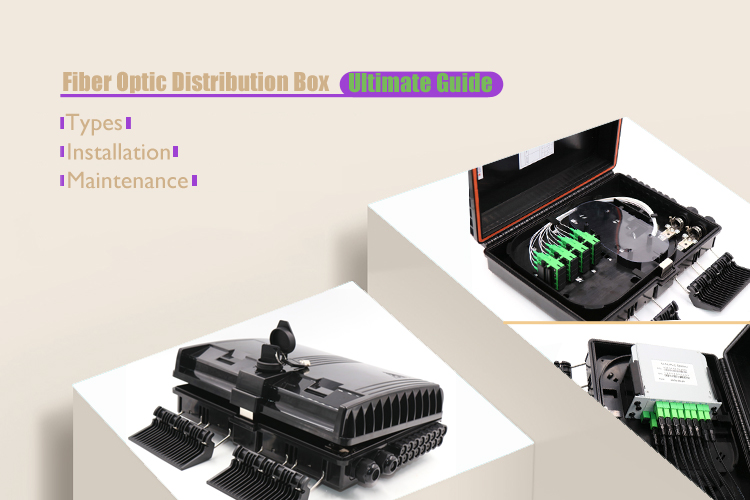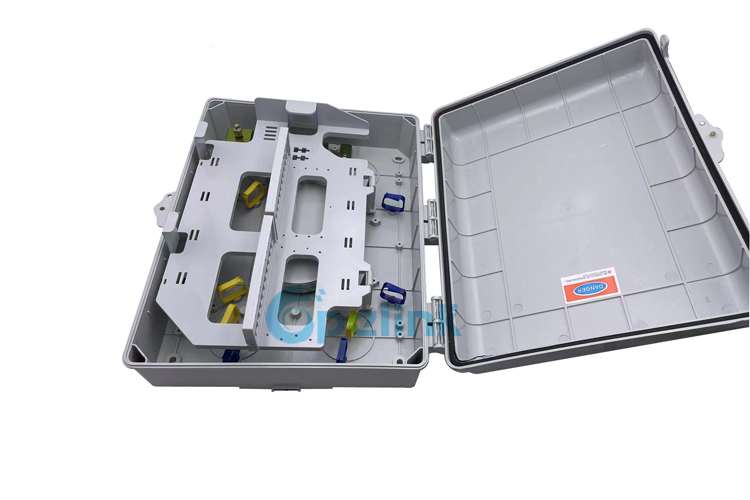Ultimate Guide to Fiber Optic Distribution Box: Types, Installation, and Maintenance
Introduction to Fiber Optic Distribution Box
Fiber optic technology has revolutionized the telecommunications industry, enabling faster and more reliable data transmission. One essential component of a fiber optic network is the fiber optic distribution box. In this article, we will delve into the world of fiber optic distribution boxes - what they are, their importance, types, installation process, advantages, common challenges, maintenance practices, and future trends.

What is a Fiber Optic Distribution Box?
A fiber optic distribution box, also known as a fiber optic terminal box or fiber optic termination box, is a device used to connect and manage fiber optic cables in a network. It serves as a central point for fiber optic cable termination, splicing, and distribution. The distribution box provides protection and organization for the delicate fiber optic cables and ensures efficient connectivity between different network components.
Importance of Fiber Optic Distribution Box in Telecommunications
The fiber optic distribution box plays a crucial role in the telecommunications industry. It serves as a connection point for fiber optic cables coming from different directions, allowing for easy distribution to various network devices such as switches, routers, and customer premises equipment (CPE). Without a distribution box, managing and organizing the numerous fiber optic cables would be a complex and messy task.
Types of Fiber Optic Distribution Boxes
There are several types of fiber optic distribution boxes available, each designed for specific installation environments and requirements. Let's explore some of the common types:
1.Wall-Mounted Fiber Optic Distribution Box
As the name suggests, wall-mounted fiber optic distribution boxes are installed on walls or other vertical surfaces. These boxes are compact and suitable for indoor applications where space is limited. They provide a neat and organized solution for terminating and distributing fiber optic cables.
 2.Rack-Mounted Fiber Optic Distribution Box
2.Rack-Mounted Fiber Optic Distribution Box
Rack-mounted fiber optic distribution boxes are designed to be installed in standard 19-inch equipment racks. These boxes are commonly used in data centers and telecommunication rooms where multiple fiber optic connections need to be managed in a centralized manner. Rack-mounted distribution boxes offer high-density termination and easy cable management.
3.Outdoor Fiber Optic Distribution Box
Outdoor fiber optic distribution boxes are designed to withstand harsh environmental conditions. They are made of weather-resistant materials and provide protection for fiber optic cables in outdoor installations. These boxes are often used in fiber-to-the-home (FTTH) deployments, where fiber optic connections are brought directly to residential or commercial buildings.
4.Dome-Shaped Fiber Optic Distribution Box
Dome-shaped fiber optic distribution boxes are specifically designed for aerial or underground installations. These boxes have a dome-shaped enclosure that provides protection against moisture, dust, and other environmental factors. They are commonly used in fiber optic network deployments that require robust and reliable connections.
Components of Fiber Optic Distribution Box
A fiber optic distribution box consists of several components that enable proper cable termination, splicing, and distribution. Let's take a look at some of the key components:
1.Splice Trays
Splice trays are used to hold and protect the fiber optic splices. They provide a secure and organized platform for splicing the individual fibers together. Splice trays are typically removable, allowing for easy access and maintenance.
2.Fiber Optic Connectors
Fiber optic connectors are used to terminate the fiber optic cables. These connectors ensure a reliable and low-loss connection between the fibers and the distribution box. Common types of fiber optic connectors include SC, LC, and ST connectors.
3.Fiber Optic Splitters
Fiber optic splitters are used to divide a single fiber optic signal into multiple signals. They allow for efficient distribution of the optical signal to multiple network devices or end-users. Splitters can be installed inside the distribution box, enabling easy integration with the fiber optic cables.
4.Patch Panels
Patch panels provide a convenient interface for connecting the fiber optic cables to various network devices. They allow for easy patching and reconfiguration of the network connections. Patch panels are typically installed inside the distribution box, providing a centralized and organized solution.
Installation of Fiber Optic Distribution Box
The installation of a fiber optic distribution box requires careful planning and execution to ensure optimal performance and reliability. Here are the steps involved in the installation process:
1.Preparing the Installation Site
Before installing the distribution box, it is important to select an appropriate location. Consider factors such as accessibility, cable routing, and environmental conditions. Ensure that the installation site meets the necessary safety requirements and regulations.
2.Mounting the Distribution Box
Once the installation site is prepared, mount the distribution box securely. Follow the manufacturer's guidelines and use appropriate mounting hardware. Ensure that the box is properly aligned and leveled.
3.Connecting the Fibers
After mounting the distribution box, it's time to connect the fiber optic cables. Strip the cable jackets carefully and clean the fiber ends using lint-free wipes and alcohol. Terminate the fibers using the appropriate connectors and splice them together if necessary. Use splice trays or patch panels for proper organization and protection.
4.Testing the Connections
After the fiber connections are made, it is essential to test them to ensure proper functionality. Use a fiber optic testing tool such as an optical time-domain reflectometer (OTDR) to measure the signal quality and detect any potential issues. Perform comprehensive testing to verify the integrity of the connections.
Advantages of Fiber Optic Distribution Box
Fiber optic distribution boxes offer several advantages over traditional copper-based solutions. Let's explore some of the key benefits:
1.Efficient Cable Management
The distribution box provides a centralized and organized solution for managing fiber optic cables. It allows for easy identification, tracing, and troubleshooting of the cables. Proper cable management reduces the risk of cable damage and improves overall system performance.
2.Easy Maintenance and Troubleshooting
With a distribution box, maintenance and troubleshooting become more efficient and less time-consuming. The organized layout and accessibility of the cables make it easier to locate and address any issues. This results in reduced downtime and improved network reliability.
3.Scalability and Flexibility
Fiber optic distribution boxes are designed to accommodate future expansions and changes in the network. They offer scalability and flexibility, allowing for easy addition or removal of fiber optic cables and components. This makes them ideal for evolving network requirements.
4.Improved Signal Quality
Fiber optic cables provide superior signal quality compared to copper cables. The distribution box ensures proper termination and management of the fiber optic cables, minimizing signal loss and maintaining a high-quality optical connection. This leads to improved data transmission and network performance.
Common Challenges and Troubleshooting Tips
While fiber optic distribution boxes offer numerous benefits, they can also face certain challenges. Here are some common issues and troubleshooting tips:
1.Fiber Optic Signal Loss
Signal loss in fiber optic networks can occur due to various factors such as dirty connectors, excessive bending of fibers, or faulty splices. Regular inspection and cleaning of connectors, proper cable routing, and ensuring accurate fiber splicing can help minimize signal loss.
2.Fiber Optic Connector Issues
Connectors are critical components in fiber optic networks and can sometimes become loose or damaged. Regularly inspect the connectors and ensure proper connection and alignment. If a connector is found to be faulty, replace it with a new one.
3.Environmental Factors
Outdoor installations may face environmental challenges such as temperature variations, moisture, or physical damage. Ensure that the distribution box is designed to withstand these factors and take appropriate measures such as sealing the box and using weather-resistant materials.
4.Cable Management Problems
Unorganized and tangled cables can lead to difficulties in maintenance and troubleshooting. Implement proper cable management practices such as using cable ties, labeling the cables, and organizing them in a logical manner. Regularly inspect the cable management inside the distribution box and make necessary adjustments.
Best Practices for Fiber Optic Distribution Box Maintenance
To ensure the optimal performance and longevity of a fiber optic distribution box, it is important to follow best practices for maintenance. Here are some key practices:
1.Regular Inspection and Cleaning
Periodically inspect the distribution box for any physical damage, loose connections, or signs of wear. Clean the connectors and splice trays using appropriate cleaning tools and solutions. Regular inspection and cleaning help prevent potential issues and maintain optimal performance.
2.Proper Cable Management
Maintain proper cable management inside the distribution box. Ensure that the cables are neatly organized, free from excessive bending or tension, and properly labeled. This facilitates easy maintenance, troubleshooting, and future expansions.
3.Updating and Upgrading Equipment
Stay updated with the latest technological advancements and industry standards. Regularly check for firmware or software updates for the distribution box and other related equipment. Consider upgrading the equipment if necessary to keep up with evolving network requirements.
4.Training and Certifications
Ensure that the personnel responsible for maintaining the distribution box are adequately trained and certified. Training programs and certifications provide the necessary knowledge and skills to handle fiber optic networks effectively. This helps reduce the risk of errors and ensures proper maintenance practices.
Future Trends in Fiber Optic Distribution Boxes
As technology continues to advance, fiber optic distribution boxes are expected to evolve as well. Some future trends in this field include:
.Increased adoption of compact and modular distribution box designs
.Integration of advanced monitoring and management features
.Deployment of distribution boxes with higher fiber density
.Implementation of automated and intelligent cable management systems
.Advancements in fiber optic connector technology for improved performance and reliability
Conclusion
Fiber optic distribution boxes are essential components in modern telecommunications networks. They provide a centralized and organized solution for managing fiber optic cables, enabling efficient connectivity and distribution. By understanding the types, components, installation process, advantages, and maintenance practices associated with fiber optic distribution boxes, network administrators can ensure optimal performance and reliability. Stay updated with the latest industry trends to harness the full potential of fiber optic technology and meet the ever-increasing demands of the digital age.
FAQs
1. What is the purpose of a fiber optic distribution box?
A fiber optic distribution box serves as a central point for fiber optic cable termination, splicing, and distribution. It provides protection and organization for the cables and ensures efficient connectivity between network components.
2. What are the types of fiber optic distribution boxes?
Some common types of fiber optic distribution boxes include wall-mounted, rack-mounted, outdoor, and dome-shaped boxes. Each type is designed for specific installation environments and requirements.
3. How do I install a fiber optic distribution box?
The installation process involves preparing the installation site, mounting the distribution box securely, connecting the fibers, and testing the connections for proper functionality.
4. What are the advantages of fiber optic distribution boxes?
Fiber optic distribution boxes offer efficient cable management, easy maintenance and troubleshooting, scalability and flexibility, and improved signal quality compared to traditional copper-based solutions.
5. What are some common challenges in maintaining fiber optic distribution boxes?
Common challenges include fiber optic signal loss, connector issues, environmental factors, and cable management problems. Regular inspection, cleaning, and proper cable management practices can help mitigate these challenges.


 The Future of Fiber Optic Communication Network Architecture: Evolution and the Role of SDON Technology
The Future of Fiber Optic Communication Network Architecture: Evolution and the Role of SDON Technology
 What opportunities and challenges does free-space optical communication technology face?
What opportunities and challenges does free-space optical communication technology face?
 Opelink MPO Products for High-Speed Data Center Applications
Opelink MPO Products for High-Speed Data Center Applications
 CWDM vs. DWDM: Which Optical Transmission Technology Should You Choose?
CWDM vs. DWDM: Which Optical Transmission Technology Should You Choose?